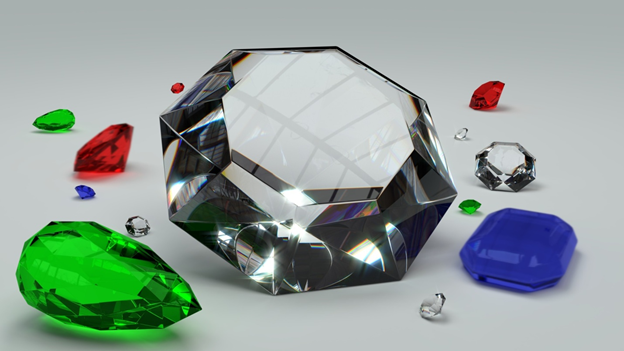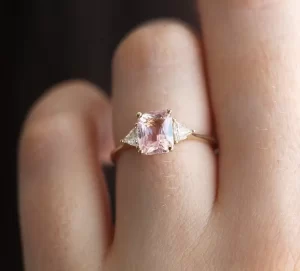The Different Types of Jewels You Can Find at a Jeweler

When the light hits a gemstone just right, it can create a rainbow of color and light in the air. It’s easy to see why even our ancient ancestors were fascinated by all different types of jewels.
When you visit a jewelry store today, it’s easy to get overwhelmed by the sheer number of options on display. Should you choose a sparkling diamond? What about a glittering amethyst or a mysterious opal?
It helps to know what you can expect to find before you walk in. Today, we’re sharing a few of the most common types of gemstones and jewels you’ll find at your local jeweler’s shop.
Diamonds
There’s a reason why diamonds are the preferred gemstone for wedding jewelry around the world. Not only are they exceptionally beautiful, but they’re also more durable than you might expect! In fact, diamonds are the hardest naturally occurring material on Earth.
While scientists and researchers believe they may have found a carbon allotrope that’s slightly harder than a natural diamond, they need to conduct more studies to understand its makeup. Traditionally, diamonds have been placed in a variety of different jewelry settings. You can find them in engagement rings, wedding bands, necklaces, earrings, and more.
Red Rubies
Rubies are a special variety of the mineral corundum. All other varieties of corundum are called sapphires. Red rubies are hard and durable like diamonds, and they also possess a special type of allure.
The mystique surrounding rubies comes from the fact that these jewels are rarer than both diamonds and sapphires. They’re often used as accent stones in jewelry, as their deep and bold color offsets many different types of gemstones.
Green Emeralds
Of all the different types of gemstones, emeralds are arguably the most unique. This is because each stone contains distinct inclusions that set it apart from any other jewel.
Emeralds belong to a group of stones called beryls, along with other similarly-hued jewels such as aquamarine. Green emeralds are eye-catching and look great when paired alongside other colorful gems or left to shine on their own. Unlike ultra-hard diamonds and rubies, emeralds tend to be softer and can break more easily.
If you purchase one from your local jeweler, be careful not to wear it in settings where it could get damaged. It’s also smart to keep it away from moisture, which could cloud its appearance.
Aquamarine
Need something new and something blue for your wedding day? If so, then look for a piece of jewelry that features an aquamarine gemstone! Classified as a type of beryl, it’s a cousin to the beautiful emerald.
While some aquamarine stones are light blue in color, others are more intense and can even feature a combination of blue and green. This is one of the hardest gems available, and it’s capable of withstanding plenty of daily wear and tear.
Blue Sapphires
While sapphires can naturally occur in many different colors, jewelry stores tend to carry blue varieties most often. Unlike aquamarine or another blue gem, blue sapphires have a deeper and darker shade. As mentioned, all sapphires belong to the corundum family.
Like diamonds, emeralds, and rubies, sapphires are considered highly precious stones. It’s a popular choice for gemstone rings and is usually set in a white gold band to allow the color to pop.
Tanzanite
Do you want to incorporate shades of purple into your jewelry collection? If so, then tanzanite is a great place to start! This jewel wasn’t discovered until the late 1960s.
While exact stories of discovery vary, the most widely accepted claim is that a team of Maasai herders discovered blue crystal gemstones within the Merelani Hills, located near Arusha, Tanzania. Today, the only true forms of tanzanite still come all the way from Tanzania.
As you might expect, this makes this gem both rare and valuable. It’s not as hard as the gems described above, but it’s highly sought-after and makes a gorgeous ring or necklace. You can view this tanzanite stone to learn more about it and shop for various designs!
Amethyst
Amethyst is another purple gem that’s both versatile and durable. If Tanzanite is outside of your budget, this can be an excellent alternative. Technically, this jewel is a type of quartz.
It gets its captivating purple hue from iron that’s stored deep within its crystalline structure. If there is a substantial amount of iron present, the amethyst will be dark purple. If there’s less iron, then it will be lighter in color.
Pink Sapphires
Pink sapphires also belong to the corundum family of jewels. Their color can range from light pink to deep magenta. For this reason, they’re often compared and classified alongside red rubies.
While blue sapphires have long dominated the market, these are quickly gaining attention and popularity. Yet, until their status reaches that of their blue relatives, these are usually more affordable and easier to find in the store.
Citrines
When you think of citrus, do you picture the beautiful yellow hue of a ripe lemon? If so, then you’ll love citrine jewels! These special gems showcase a dazzling yellow color that turns heads at the jewelry store.
Cousins to amethysts, citrines get their color when the iron inside of quartz crystals turns hot. Given enough time, this process will occur naturally without any type of human interaction. However, jewelers and gem enthusiasts have discovered that they can replicate the process using a man-made heat treatment.
If you want an extra-clear citrine stone, then you can expect to pay a little more. However, you can find other varieties that are equally stunning but available at a lower price point.
Fire Opal
As its name suggests, fire opal is a striking type of gemstone. This jewel features varying shades of both orange and yellow, giving it the appearance of flames.
You can find fire opals that originate in a variety of different countries, including Africa and Mexico. They are even sourced right in the United States, with Oregon seeing most of the mining activity.
Before you purchase a fire opal, pay close attention to the setting. This isn’t a gem that can sustain a ton of daily use, because it contains many internal fissures that give it its unique appearance.
While those delicate cracks give fire opals their spectacular look, they also weaken their structure. As such, the stone needs to be protected by the structures that surround it. As long as it’s placed in the right setting, you should be able to wear it on special occasions without worry.
Iolites
You might not have heard of iolites, but don’t let that stop you from asking your local gemstone guide about it. This is a gem that can appear blue or violet depending on the variety.
When you turn an iolite around in your hands, you may notice that the light catches it in different ways, changing its color with each rotation. At some angles, it can even appear perfectly clear! For that reason, some people refer to it as a “water sapphire”.
If you love blue gems but don’t want to pay the high price that a sapphire or tanzanite can command, then give an iolite a try! We do recommend steering clear of rings, though.
When struck, iolites tend to fracture completely in a singular direction. This makes them better suited for necklaces or earrings, where they’re less likely to experience a direct impact. If you do choose an iolite ring, make sure the setting completely surrounds and protects the stone.
Garnets
When most people think of garnets, they picture a purple or red stone. However, did you know that you can find garnets in a variety of different colors, including brown, green, orange, and pink?
While these jewels are popular among buyers, there are far more of them mined than you’ll find in the store. This is because only a select number of garnets meet all of the technical specifications required to be sold as jewelry.
Compared to other precious stones, garnets tend to be among the most affordable. These make great everyday gems and can be placed in many settings depending on your preference.
Explore These Different Types of Jewels
A visit to your local jewelry store can fill you with inspiration and anticipation. Whether you’re just browsing or looking for a special occasion, you’re sure to find plenty of pieces that catch your eye.
While the associate can explain all of the different types of jewels on display, this guide can help you understand the price point and unique qualities of each one. Now, you’re ready to choose a stone that you love and can wear proudly every day!
Looking for more advice on everything from education to technology? Check out our other helpful guides today!







